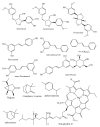Conifers Phytochemicals: A Valuable Forest with Therapeutic Potential
- PMID: 34070179
- PMCID: PMC8158490
- DOI: 10.3390/molecules26103005
Conifers Phytochemicals: A Valuable Forest with Therapeutic Potential
Abstract
Conifers have long been recognized for their therapeutic potential in different disorders. Alkaloids, terpenes and polyphenols are the most abundant naturally occurring phytochemicals in these plants. Here, we provide an overview of the phytochemistry and related commercial products obtained from conifers. The pharmacological actions of different phytochemicals present in conifers against bacterial and fungal infections, cancer, diabetes and cardiovascular diseases are also reviewed. Data obtained from experimental and clinical studies performed to date clearly underline that such compounds exert promising antioxidant effects, being able to inhibit cell damage, cancer growth, inflammation and the onset of neurodegenerative diseases. Therefore, an attempt has been made with the intent to highlight the importance of conifer-derived extracts for pharmacological purposes, with the support of relevant in vitro and in vivo experimental data. In short, this review comprehends the information published to date related to conifers' phytochemicals and illustrates their potential role as drugs.
Keywords: anti-inflammatory; antibacterial; anticancer; conifers; neurodegenerative; oxidative stress; phytoconstituent.
Conflict of interest statement
The authors declare no conflict of interest.
Figures





References
-
- Mustafa G., Arif R., Atta A., Sharif S., Jamil A. Bioactive Compounds from Medicinal Plants and Their Importance in Drug Discovery in Pakistan. Matrix Sci. Pharma. 2017;1:17–26. doi: 10.26480/msp.01.2017.17.26. - DOI
-
- Abdel-Razek A.S., El-Naggar M.E., Allam A., Morsy O.M., Othman S.I. Microbial natural products in drug discovery. Processes. 2020;8:470. doi: 10.3390/pr8040470. - DOI
-
- Nisar B., Sultan A., Rubab S.L. Comparison of Medicinally Important Natural Products versus Synthetic Drugs-A Short Commentary. Nat. Prod. Chem. Res. 2018;06:308. doi: 10.4172/2329-6836.1000308. - DOI
Publication types
MeSH terms
Substances
LinkOut - more resources
Full Text Sources

